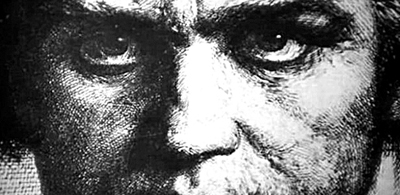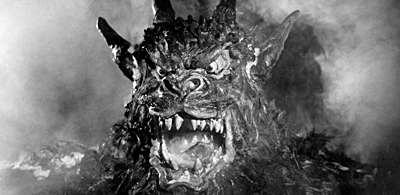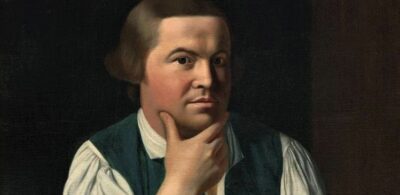How do you know you’re not a Fascist?
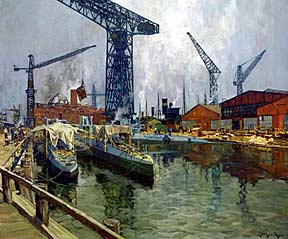
The shipyard with its giant construction cranes and warehouses, still waters and slate gray skies, makes for quite a beautiful oil painting. The artist applied a heavy impasto of vibrant colors using large bristle brushes, and also used a palette knife to trowel on the hot and cool hues of gray that make up the leaden clouds. But aside from the technical prowess of the artist, what does the painting say to us? One could bring up the mood cast by the canvas, or perhaps comment on the emotional responses to such a scene, but we shouldn’t overlook the artist’s intent – which was to comment on the labor of ship building in the year 1944.

Now let’s consider the next canvas by the same artist, another understated examination of labor – but one created as a landscape painting in 1940. The artist has depicted a rough landscape of rocky crags whose crests are topped by verdant green meadows and trees. A second glance reveals a rock quarry, where workers toil at extracting blocks of stone from the mountainside. Like the first painting, a palette knife has created startling realistic effects, the living rock of the quarry made all the more believable by the artist’s experienced hand. But again – what does this painting say to us?
Apart from their shared realism, the paintings have other commonalities. Both focus on the intensity of the natural world, with the presence of the workers a mere sidebar – in fact, there are no workers to be seen in the shipyard painting at all. The two paintings also deal with the idea of monumentality, giant mechanized cranes looming over a harbor, and enormous slabs of stone hewn from a colossal ridge. The artworks minimize the role of human hands in labor, and instead offer panoramas that might have been fashioned by supernatural forces.
Artworks are never simply artworks. There are always implications and meanings attached to them, whether artists admit to this or not – and there are most certainly ramifications associated with better known works. The paintings I’m discussing here make for an excellent example. Both were created by German artist, Erich Mercker, and both were commissioned by Adolph Hitler and the Nazi Party in order to celebrate the building of infrastructure in fascist Germany. The tranquil looking shipyard is a depiction of the harbor where the Nazi U-Boat fleet was built, the same wartime armada of deadly submarines that menaced Atlantic shipping and blockaded Britain. The painting of the quarry shows workers cutting stone to be used in the construction of the Nazi seat of power in Berlin. Moreover, since Germany’s able-bodied men were at the time in uniform and occupying eight European countries from Austria to France, and the Nazi war machine was preparing its 1941 invasion of the Soviet Union – the workers in the painting are more than likely slave laborers conscripted from concentration camps.
While my assessment of Mercker’s paintings can serve as a lesson in peeling back the hidden layers of meaning in an artwork, that is by no means the point of my article. Nor do I mean to scrutinize the role and responsibilities that I believe an artist has – which is always a topic of discussion on this web log. However, I do wish to point out that Mercker’s paintings – and works of art by other German artists commissioned by the Nazis, are now on view at an American museum that has failed to identify the paintings as Nazi propaganda.
I’m not at all offended that the Man at Work museum at the Milwaukee School of Engineering in Milwaukee, Wisconsin, would decide to show such works, as I’m of the opinion that displays of artworks created by artists of the Third Reich are allowable provided extraordinary care is taken to identify the works for what they are. However, the Man at Work museum has taken no such precautions. On the contrary, the labels, supporting text and other documents pertaining to the exhibited Nazi commissioned artworks make no mention of their origins. For instance, the Man at Work museum website merely identifies Erich Mercker as a painter who created “colorful images of steel mills and foundries, bridge and ship-building, quarries and interior views of factories.” No reference is made to what those industrial sites and quarries were manufacturing, and no mention is made of who paid Mercker and where his works were exhibited.
It is repulsive that the Man at Work museum has chosen not to clearly identify some of the artworks in its holdings as Nazi propaganda. The museum has 81 Erich Mercker paintings in its possession, canvases that were not only directly commissioned by the Nazi regime, but glorify that government’s construction projects. For instance, the museum displays Mercker’s painting, Congress Hall in Nuremberg Under Construction, without mentioning or explaining that the building depicted is none other than the main Congress hall for the Nazi party, and that it marked the entrance to the Nazi party rally grounds were the infamous Nuremberg Rallies were held annually.
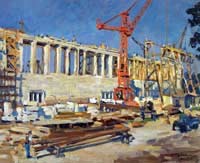
The Milwaukee Journal Sentinel ran an excellent article on Oct. 27, 2007, titled: Art with Nazi links raises questions for new museum. The article noted that museum director John Kopmeier opposed providing proper labeling and historical context for the Nazi commissioned artworks, saying: “I could argue against this… it is of no interest to us.” This hardly seems a reasonable – let alone a professional stance – for the director of a museum; but then, as noted in the Sentinel’s article, Kopmeier has no “professional expertise in art or art history,” and “there is no professional curator on the museum’s staff.”
The Man at Work museum was supposedly intended to celebrate labor through the ages, but the most political of all human endeavors – work – is presented by the museum in the most apolitical manner, or so it seems at first glance. Industrialist Eckhart G. Grohmann donated his extensive art collection to the Milwaukee School of Engineering, who have housed the collection in their newly dedicated museum. Grohmann’s collection is focused on the theme of labor and is principally composed of German and Northern European artists. For the most part the artists in the collection are little known, but in the case of Erich Mercker, Ferdinand Staeger, and Ria Picco-Ruckert – history obliterated their names due to their collaboration with Hitler’s regime.
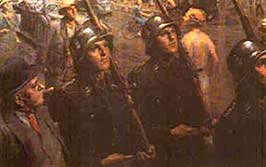
While Erich Mercker was not a member of the Nazi party, he was highly favored by the Nazi hierarchy and his paintings were collected by party members. Mercker also exhibited at the Grosse deutsche Kunstausstellung (Great German Art Exhibition), the inaugural exhibit of the Nazi “House of German Art” where the Third Reich displayed what they considered to be the finest artworks created by the “master race.” Ferdinand Staeger also exhibited at Nazi authorized venues, including the Great German Art Exhibition, and Hitler himself was an enthusiastic collector of Staeger’s works. Ria Picco-Ruckert lionized fascist ideals regarding work and collective struggle, and her painting at the Man at Work museum portrays German workers involved in war production at a steel factory. Picco-Ruckert also exhibited her work at the notorious Nazi Party Congress held in Nuremberg.
It can be argued that some German artists joined the Nazi party or took commissions from them, especially in the early years of the regime, “just to get a job.” Many people were swept up in the ultra-nationalism and conservatism that brought the fascists to power, without fully comprehending how their participation would ultimately lead their country, and the world, to such incomprehensible ruin. But after a certain point it became impossible not to know what was occurring. It was well understood that those “degenerate” artists who strayed from Nazi aesthetics would face severe punishment. Many were dismissed from teaching positions, banned from exhibiting, selling or even creating art. Countless others simply disappeared into concentration camps.
There’s no doubt Erich Mercker, Ferdinand Staeger, and Ria Picco-Ruckert were fully cognizant of what was taking place in their country, and the Man at Work museum is obligated to acknowledge this by properly labeling, with explanatory text – the ghastly history behind some of the paintings in its collection.


